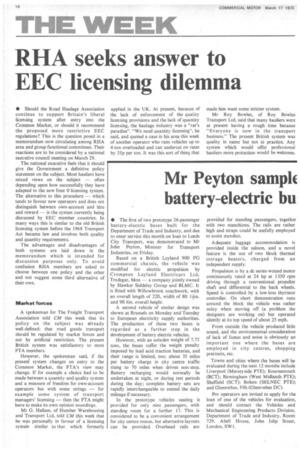Mr Peyton samplc battery-electric bu
Page 18

If you've noticed an error in this article please click here to report it so we can fix it.
• The first of two prototype 26-passenger battery-electric buses built for the Department of Trade and Industry, and due to enter service this month on loan to Leeds City Transport, was demonstrated to Mr John Peyton, Minister for Transport Industries, on Friday.
Based on a British Leyland 900 FG commercial chassis, the vehicle was modified for electric propulsion by Crompton Leyland Electricars Ltd, Tredegar, Mon — a company jointly owned by Hawker Siddeley Group and BLMC. It is fitted with Willowbrook coachwork, with an overall length of 22ft, width of 8ft 1-1-in. and 9ft 6in. overall height.
A second vehicle of similar design was shown at Brussels on Monday and Tuesday to European electricity supply authorities. The production of these two buses is regarded as a further step in the development of battery electric vehicles-.
However, with an unladen weight of 7.75 tons, the buses suffer the weight penalty imposed by lead acid traction batteries, and their range is limited, too; about 35 miles per battery charge in city centre traffic rising to 70 miles when driven non-stop. Battery recharging would normally be undertaken at night, or during rest periods during the day; complete battery sets are rapidly interchangeable to extend the daily mileage if necessary.
In the prototype vehicles seating is provided for only nine passengers, with standing room for a further 17. This is considered to be a convenient arrangement for city centre routes, but alternative layouts can be provided. Overhead rails are provided for standing passengers, together with two stanchions. The rails are rather high and straps could be usefully employed to assist standees.
Adequate luggage accommodation is provided inside the saloon, and a novel feature is the use of two block thermal storage heaters, charged from an independent supply.
Propulsion is by a dc series-wound motor continuously rated at 24 hp at 1350 rpm driving through a conventional propeller shaft and differential to the back wheels. Speed is controlled by a low-loss thyristor controller. On short demonstration runs around the block the vehicle was rather noisy when moving off (a problem the designers are working on) but operated silently at its top speed of about 25 mph.
From outside the vehicle produced little sound, and the environmental consideration of lack of fumes and noise is obviously an important one where the buses are employed in city centres, shopping precincts, etc.
Towns and cities where the buses will be evaluated during the next 12 months include Liverpool (Merseyside PTE); Bournemouth (BCT); Birmingham (West Midlands PTE); Sheffield (SCT); Bolton (SELNEC PTE); and Glenroth es, Fife (Glenrothes DC).
Psv operators are invited to apply for the loan of one of the vehicles for evaluation, and should contact the Vehicles and Mechanical Engineering Products Division, Department of Trade and Industry, Room 729, Abell House, John Islip Street, London, SW1.










































































































